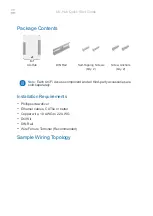
Provisioning
152-388-115-03, Issue 03
22
April 21, 2000
H2TU-C-388 List 1E
HDSL2 BER (HBER) Option.
The HBER option permits the monitoring of loop integrity and reporting of
alarms when excessive errors are detected. The PM primitive used for this purpose is the CRC checksum
performed on the HDSL2 frame for both directions of transmission. It is, therefore, called a block error rate rather
than the bit error rate associated with the DS1 interface. The CRC errors and counts are displayed on the Monitor
screen for both the H2TU-C and H2TU-R.
The HBER option allows an alarm to be generated if the total number of CRCs at either the H2TU-C or H2TU-R
exceeds the selected BER threshold during the last 1-minute interval.
•
HBER option = 1E-6. Alarm is generated if CRC > 92
•
HBER option = 1E-7. Alarm is generated if CRC > 9
Once initiated, the HBER count clears when the CRC count drops below the selected threshold. Selecting NONE
inhibits this alarm.
DS1 BER (DBER) Option.
The DS1 BER alarm occurs when any of the DS1 or DSX-1 performance
monitoring parameters listed in
exceed the counts shown for the 24-hour period between 12:00:00 AM
through 11:59:59 PM. These thresholds correspond to a 10
-6
BER. All PM counters clear to zero at 12:00:00 AM
or when Master Clear is selected.
H2TU-R DS1 Frame Conversion (CONV) Option.
Frame format conversion is only applicable to the
remote H2TU-R, but selectable by the H2TU-C or H2TU-R. This option enables the network to be ESF, which is
used to embed SPRM or NPRM into the datalink toward the network. During conversion, frame bit errors are
regenerated to ensure transparency.
The HDSL2 system attempts to find ESF or SF framing or determines that no framing exists. The DS1 framing is
then synchronized with the HDSL2 frame. If the framing is lost, the system generates an Out-of-Frame (OOF)
defect which results in UAS-P. As a result, the system reverts to frame search mode.
This option has the following settings:
•
OFF: No frame conversion occurs. All framing issues are determined by the FRMG option settings of AUTO
and UNFR.
•
ACON: This is the automatic conversion setting. If the system detects ESF from the network and SF from the
CPE, it automatically converts the CPE SF to ESF toward the network as well as the network ESF to SF
toward the CPE.
Upon power-on-reset, after loopdown, or after changing the frame conversion option, the framing needs to
be re-established before a complete conversion occurs. If there is a failure condition (LOS, AIS, or LOF)
during steady state, the previous conversion state is maintained to ensure continuity when the system returns
from the failure condition.
If SF is received from the network, the H2TU-R forces an ESF toward the network for about 1.5 seconds.
This signals to the far-end PM-NIU at the network boundary that frame conversion is requested. If the far-end
PM-NIU is capable of conversion, it changes the framing to ESF. If not, then the H2TU-R reverts to SF and
does not apply any conversion.
Table 7.
DS1/DSX-1 24-hour PM Threshold
Parameter
Threshold Count
CV-L (BPV)
133,400
ES-L, ES-P, PRM, PDVS-L
648
SES-L, SES-P
100
UAS-P, UAS-L
10















































